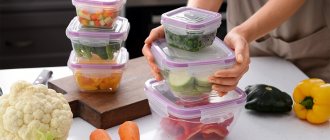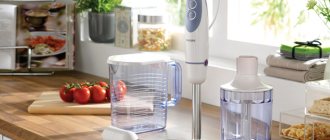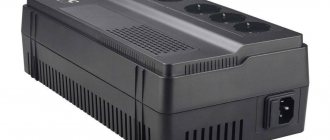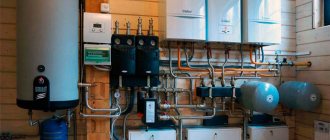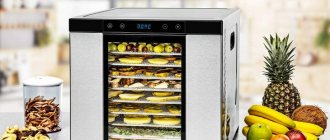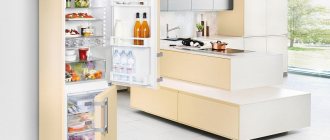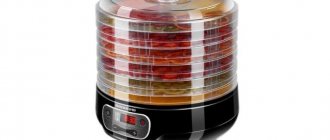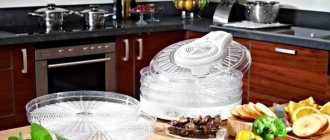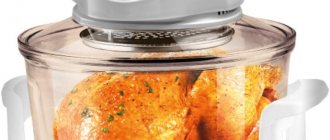The culture of healthy eating continues to develop - more and more people of different age categories are giving up junk food. Proper cooking is in fashion today, so people pay attention to special household appliances that allow them to create healthy and tasty dishes. Drying is one of the food processing methods that allows you to preserve valuable substances in food and prepare food in advance. This way you can prepare fruits, vegetables, meat - using a dehydrator. Here's what user Marishka writes:
Mariska
“Hi! My mother-in-law and I (I gave it to her) have Sukhovey dryers for 5 pallets. Both I and my mother-in-law are very pleased with the drying. I don’t know what exactly my mother-in-law is drying. I dry vegetables (carrots, parsley, onions), mushrooms are great!!”
A dehydrator is often called a dryer, since the operating principle of these devices is the same. But there are significant differences. A dehydrator can use a low temperature of 40 ° C, while a dryer can only use hot air. The first distributes the heat evenly, and in the dryer it usually comes from the bottom, so pieces of food on the lower trays can burn. It is impossible to preserve enzymes and other beneficial substances of some types of foods at such high temperatures, so a dehydrator is preferable.
If you want to use this miracle technology, it is important to pay attention to a number of features of a food dehydrator when purchasing - devices can differ significantly from each other.
Principle of operation
To understand what exactly to look for when choosing a dehydrator for vegetables and fruits, it is good to learn more about the operating principle of the device. The device heats the air inside a closed chamber, which circulates, drying pre-prepared products. The dehydrator dryer consists of the following main parts:
- housings;
- heating element
- fan;
- temperature sensor.
The heating intensity of the air flow is adjustable. For this purpose, there is a control panel on the case. Vegetables, fruits, mushrooms or other products are pre-cut (into slices, slices, strips) and laid out on pallets in the form of a mesh that allows air flow to pass through. The operating temperature range of the device is from 35 to 70°C.
Some of the latest dehydrators are characterized by a cubic shape, more uniform heating and increased volume, which allows you to prepare considerable supplies of food. Round and compact devices are designed for drying small quantities of food. The cost of popular models is presented below (prices in different regions and stores may vary significantly):
| Name | price, rub. |
| Katrina Samobranka | 850 |
| Sukhovey M8 | 1850 |
| BelOMO 8360 | 3170 |
| VolTera Lux 1000 | 6900 |
| Summer resident-4 | 8450 |
| EzidriSnackmaker FD 500 | 11700 |
| Ezidri Ultra FD 1000 | 16200 |
The more functions and modes, the correspondingly more expensive the equipment. Some dehydrators have a whole list of special programs, a humidity sensor and other devices.
What characteristics should you pay attention to when choosing a dehydrator?
So, you are fully aware that you must have a fruit and vegetable dehydrator in your kitchen. The question remains - how to choose it? Depending on the blowing method, dehydrators are either vertical or horizontal. In vertical ones, hot air rises from below from the heating element; in horizontal ones, the heater is mounted in the rear part, and the heat is distributed evenly at all levels.
Infrared dehydrators dry fruits and vegetables using infrared rays, which range between visible red light and radio wavelengths. High temperature is not required; heating to approximately +50°C is sufficient. The products are gradually heated by infrared rays, the moisture evaporates from them, and fibers with nutrients and vitamins remain. Dehydration in such devices occurs quickly.
A convection dehydrator-dryer evaporates moisture by circulating heated air. The range of convection dehydrators is quite wide, and the price, as a rule, is not bad. However, this is where their advantages end, since the products in them tend to dry out rather than be uniformly dehydrated. In addition, the dehydration process in them is quite long.
Material
A fruit and vegetable dehydrator is made of plastic and/or metal. This determines the performance of the equipment.
In inexpensive models, the body and trays are made of plastic. This material has its advantages - it is easy to care for and is not afraid of moisture. But, according to reviews of dehydrators, models with trays made of cheap plastic become of little use after a couple of years of intensive use. Surfaces crack and grilles break. If the plastic is of high quality, then the pallets are usually quite strong and durable - they can last about 10 years or even more. Such materials are used in devices in the mid-price segment.
Ensure that all internal plastic components are food grade and BPA free. It is believed that during the heating process, toxic substances can be released into the environment and enter products. Good plastic should not have a specific smell, and equipment should have environmental and other certificates.
High quality dehydrators are supplied with stainless steel trays. Metal pallets are durable, practical, and last for several decades. When heated, they do not release toxins and are easy to care for. When purchasing, make sure that there are no defects or scratches on the metal surfaces, otherwise rust may form in these places.
Differences between a dehydrator and a dryer
Dehydrators and dryers are often confused with each other or considered synonymous with each other. The devices are really similar both in purpose and in appearance. But there are a number of fundamental differences between them. If you study the features, it becomes clear that the dryer is a simpler device, while the dehydrator is close to professional equipment.
Design and principle of operation
Electric dryers for fruits and vegetables are cylindrical in shape and consist of several removable tray tiers that can be moved from place to place. The fan is usually located at the bottom of the case and drives air through mesh trays. The design is simple, but it is quite difficult to achieve uniform drying using it. The temperature of the air flow at the bottom and top of the device is different.
The denser the dryer is loaded, the slower the pieces further away from the fan dry.
The dehydrator is usually made in a cubic shape, equipped with retractable trays and a closing door. Its device can be more complex - heating often comes from an infrared emitter, the air flow passes through special channels located in the center of the device and on the sides of the walls. In horizontal type dehydrators, fans are installed on the rear panel, which also allows for uniform processing of all built-in trays.
Temperature adjustment
An important difference between a dehydrator and a dryer is the ability to set the most precise temperature. The device is equipped with a thermostat that allows you to adjust the heating mode with an error of 1-2 °C. In this case, during the processing of products, the sensors will display a reliable temperature that is the same for the entire internal chamber of the device.
Dryers also have a thermostat, but the heating can only be adjusted roughly. The fact is that when passing through the trays of the device, the flow of warm air dissipates. In the lower part of the device the temperature corresponds to the set one, but then inevitably decreases. On the upper trays of the dryer, vegetables and fruits lose moisture more slowly, and if the lower compartments are densely loaded, they may receive virtually no heat.
Advice! To ensure uniform processing, the trays can be constantly moved from place to place, but this greatly reduces the usability of the device.
Drying quality
Budget dryers allow you to remove excess moisture from vegetables and fruits in a few hours. But the quality of processing will be rather conditional. Since the device does not allow you to accurately set the heating level, the same for all pallets, usually the lower pieces are dried better, while the upper ones remain half damp.
To compensate for temperature differences, many manufacturers increase the airflow intensity for their products. But the quality hardly changes for the better; pieces of food quickly dry out on the outside and remain moist on the inside.
The dehydrator usually holds more food
Quality dehydrators provide uniform drying for all trays located in the inner chamber. The temperature corresponds to the values set on the thermostat and does not have sudden changes. Therefore, vegetables and fruits dry both outside and inside, acquire the desired structure and retain maximum beneficial properties.
Manufacturing materials
Vegetable and fruit dryers are inexpensive, have a simple design and are usually made of cheap materials. Plastic trays do not melt during the heating process, but they can emit compounds harmful to the human body. The higher the temperature during use of the device, the greater the potential harm from fumes to health.
In more expensive dehydrators, the trays are usually made of heat-resistant plastic with a safe composition and do not emit toxic substances when heated. Some models are equipped with metal trays, and in this case the danger to human health is reduced to zero.
Fan location
The dehydrator for drying fruits and vegetables is equipped with a fan built into the chamber. The element can be bottom, top or located on the back wall.
In premium (expensive) segment models, the fan is usually side-mounted. This helps distribute heated air evenly throughout the chamber. You can watch the drying process through the transparent front door. The flow of warm air from the side (vertical) fan is cut by trays located perpendicularly and processes the products evenly. This principle is used in professional equipment - which is used to dry fruits and vegetables on an industrial scale.
The top position of the fan is rare. Such models cost more. If the fan is located at the bottom, moisture, juice, and pieces of food may fall on it. Therefore, after each cooking process, the fan will have to be thoroughly washed. The flow, rising upward, loses temperature on each tier, so products dry faster on the lower trays.
Models with horizontal fans are suitable for drying small quantities of food. The corresponding blanks can be laid out on different tiers. If products require high processing temperatures, they are placed closer to the fan.
TOP 6 models of dryers for vegetables and fruits
Vegetable and fruit dryer ESPERANZA FOOD DEHYDRATOR EKD001
Manufacturer – Esperanza, China .
The principle of using this dehydrator is simple: prepare food products - wash, dry, cut vegetables and fruits into slices, put them in the dryer. Using this drying method, the beneficial properties of fruits and vegetables are preserved, their shelf life is extended and your time is saved. The control type of this model is mechanical. Power – 125 W. Number of trays – 5 pieces. The material from which the dehydrator dryer is made is plastic. An additional function is overheating protection.
Price – $37
Vegetable and fruit dryer ZELMER FD1002
Manufacturer – Zelmer, Poland . This model of a good dryer for vegetables and fruits preserves the maximum of nutrients and vitamins. The operating principle of the dryer is convection. This model has two power modes.
The control type of this model is electronic. Power – 520 W. Number of trays – 4. The material from which the body is made is plastic. Features of this dryer model: overheat protection, timer, heating element cooling function, automatic shutdown.
Price – $75
Dehydrator (dryer) Ezidri Snackmaker FD500
Manufacturer: Hydraflow Industries, New Zealand . With the help of this dryer, products are properly dried and retain their tasty and healthy qualities for a long time. Ezidri Snackmaker is a professional dehydrator for vegetables and fruits, with vertical air flow. Reviews of the fruit dryer are very good.
Control type – electronic. Power – 500 W. The number of trays can be further increased from 5 to 15. The temperature regime changes sensory, there are three positions: low, medium, high. The material of the device is fireproof plastic. Features of this model: there is a sheet for marshmallows, a mesh sheet for small berries and herbs. If you decide to buy a dehydrator, a book of instructions and recipes is included.
Price – $196
Dehydrator King Mix KM-D12S
Manufacturer: King Mix, China. Capacious horizontal dehydrator with 12 trays. The design is thought out to the smallest detail, thanks to which during operation vegetables and fruits are evenly dried on all 12 trays at once, and not just on the central ones, which is the problem with many other models. The dehydrator kit includes additional sheets and grids for preparing marshmallows and bread, tomatoes and herbs.
The control type of this model is electronic. Power – 500/1000 W (two heating systems). The number of trays is 12. The material from which the body is made is high-quality Taiwanese plastic. Features of this dryer model: safety function, uniform airflow on all trays, operation in energy saving mode at half load, timer up to 99 hours, temperature control 35-75°C, double plastic housing.
You can buy a dehydrator for $240 (the price is for a model with steel trays).
Dehydrator (dryer) Tribest Sedona Combo SD-P9150
Manufacturer – Tribest, South Korea . The Sedona Digital Dehydrator is also a good vegetable dehydrator, with precise, efficient preparation of food products that preserves their nutritional value and taste as much as possible. This model allows you to dry vegetables and fruits, nuts, raisins, mushrooms, herbs, meat and fish, make sourdough for bread, prepare sweets, raw bread, vegetable cutlets, produce berry and fruit marshmallows, prepare fermented baked milk, yoghurts, work with various cereals, flour, drying pasta, drying meat, poultry, fish.
The control type of the electric dryer for vegetables and mushrooms is automatic, digital panel. Power – 600 W. Number of trays – 9 (+ 10 tray for leftover food products). Case material – BPA-free plastic. Features of this model: new design, side airflow, three drying modes - FAST, RAW, COMBO, half load of products, two heating elements, two temperature sensors, two fans, digital temperature display, heating control, voltage stabilizer, timer, transparent glass door, up to 300 hours of continuous silent operation. Bonus – 5 years warranty.
Price – 650 $
Dehydrator Excalibur Deluxe EXC10EL
Manufacturer: Excalibur, USA .
A model from the stylish “Stainless Steel” line – professional drying equipment. The principle of operation is horizontal drying with uniform distribution of heated air over all trays and economical energy consumption. If you decide to buy a dehydrator in Moscow Excalibur Deluxe EXC10EL. You will be able to qualitatively dry vegetables, fruits, herbs, mushrooms, prepare muesli, fruit and berry marshmallows, dry meat and fish. In the process of drying products, not only are fibers and valuable nutrients not damaged, but vitamins, enzymes, beneficial properties, primary taste, color and smell of food products are also preserved. In all operating modes of the dehydrator dryer, the antibacterial regime is observed. Control type – electronic, automatic. Power – 600 W. Number of trays – 10. Material of the body and trays – stainless steel. Features of this model: temperature control - from 28 to 72 0C, timer - from 1 to 99 hours, direct type of blowing, glass door made of transparent armored glass, easy care and cleaning of the device, because the heating element and fan are located on the back wall of the device, it can be washed in a dishwasher, BPA-free plastic, the continuous operation time of the dehydrator dryer is not limited.
Price – $1367.
Conventional or infrared heating element
There has been an increased interest among buyers in infrared dehydrators. Some models have such a heating element as an addition to the main one. It is believed that infrared radiation has a beneficial effect on food quality and human health, although there is little verified data on this. These rays heat fruits and vegetables much like the sun does.
The infrared emitter heats the food, but not the air inside the chamber, so it is believed that IR heating is more economical. But the cost of a dehydrator with an infrared heating element is higher than that of models without it. But the user can choose whether to dry their products “in the shade” or “in the sun” by turning the IR emitter on and off.
What can be dried in the machine
A device like this is really needed, because it makes life comfortable, plus it’s easy to use. You can dry the following in it:
- fruits and vegetables;
- nuts or mushrooms.
Dehydrator King Mix KM-D12S: up to 12 stainless steel trays, 2 power levels, high performance
But that is not all. A modern, high-quality dehydrator is also used to remove moisture from herbs used for medicinal purposes. The device is well suited for preparing the following food:
- pizza;
- cakes;
- pancakes;
- breads.
As a rule, the instruction manual contains a number of recipes to make the owner’s life easier.
Total area of pallets
An important parameter that is taken into account when choosing the best dehydrator is the total area of the pallets. This indicator determines how many fruits and vegetables can be prepared at a time.
Professional models have up to 10 pallets, the area of which is from 120 cm². This technique is suitable for those who eat mainly raw foods (raw foodists) or who have a large family. Professional dehydrators are used by herbalists. They can be used to dry a large amount of plant material. If users have a large garden or vegetable garden and plan to dry crops, it is also worth choosing professional large models.
Small, inexpensive models are suitable for home use. You can dry up to 5-6 medium-sized round fruits (for example, oranges, apples) in them at a time. This is a technique that has no more than 6 shelves.
How to choose a dehydrator?
As practice shows, the most important are the following factors:
- Drying principle
- Has an adjustable thermostat and fan
- Form
- View
- Price
Dehydrator drying principle
Based on the drying principle, a distinction is made between convection and infrared dryers.
Convection - uses the circulation of heated air.
Infrared - affects water molecules with infrared radiation.
The models of IR dryers known to me are “Dachnik”, “Corvette”, “Ladoga” and - amazingly marvelous - the IR drying mat “Self-assembled tablecloth”
The advantages of infrared dryers include energy savings and additional bactericidal treatment - they say bacteria cannot tolerate infrared radiation.
I personally considered the same IR radiation to be a disadvantage... well, I don’t like exposing food to additional and unknown radiation...
In principle, IR dryers are an option to consider, and if you have positive experience of using this type of dehydrator in a raw food diet, please share your opinion in the comments.
See also: Raw food diet and children
Thermostat and fan in dehydrator
Having an adjustable thermostat for a raw food dehydrator, you understand, is absolutely necessary.
At temperatures above 45C, food enzymes are destroyed, and the whole idea of healthy drying loses its meaning.
All models without the ability to adjust the temperature are not included in our range of interests.
I dry everything, setting the temperature to 40C, and only for herbs I lower it to 35C.
Another important detail is the fan. Make sure that the model you choose has one, as the presence of a fan makes drying more even and prevents food from overheating.
Dehydrator shape
Dehydrators come in round and square shapes.
There are also flat infrared dryers - the already mentioned “Self-assembled tablecloth” and another innovation - the vegan “Sunstone Imitator” stove.
I didn’t consider IR dryers for myself, but to compare the characteristics of round and square dehydrators, I made the following sign:
| Square shape | Round form | |
| 1. Location of heating element and fan | On the back wall - thus, the air is heated and distributed evenly along all trays. | Most often at the bottom of the device - thus, the lower trays heat up more and to prevent this, you need to rearrange them. There are dryers with top heating. Not all models have a fan. |
| 2.Location of pallets | Horizontal – it’s convenient to remove them and there is no need to rearrange them. | Vertical, on top of each other - to rearrange, you need to disassemble the entire structure. |
| 3.Shape of pallets | Square – increases the drying surface by 25%. It is convenient to make large square sheets of bread or marshmallows. | Round, with a hole in the middle - small drying surface, there are no suitable round silicone sheets for drying. |
| 4.Drying time and quality | The horizontal arrangement ensures uniform drying without the need to rearrange the trays. | The more trays there are, the further the top products are removed from the heating element - this increases the drying time and requires rearranging the trays. |
| 5.Use of special drying sheets | Yes. Both parchment and special silicone sheets are square in shape. | No, since the use of sheets blocks the air flow coming from below or above. |
| 6.Functionality | You can remove some of the pallets and dry bulky products and objects (especially important for needlewomen). | There is only a certain configuration that limits the drying chamber. |
| 7.Care of the device | Easy to clean - drops and crumbs fall onto the flat tray at the bottom of the dehydrator. | Difficult to clean - drops fall on parts of the heating element located below. This, by the way, can cause a breakdown. |
Perhaps I did not take into account and describe all the advantages and disadvantages of different forms. In addition, a new round dryer, Ezidri, has appeared on the market, which corrects some of the shortcomings of round dryers.
But I still preferred the square shape of the dehydrator.
Type of dehydrator
- Color – I think that white appliances look more organic in the kitchen.
- Number of pallets - the more there are, the larger the dehydrator. In a small kitchen, when literally every centimeter counts, the size of the equipment is an important factor. On the other hand, if you plan to cook a lot of food, it makes sense to take this into account. So, in my experience, bread made on three dehydrator sheets “go away”, if there are three people, during one meal.
- Material of the body and trays - it is believed that the safest plastic for contact with food is polypropylene. And also pay attention to the opacity of the case - there is no need to expose the products to additional exposure to light.
- The presence of a timer is a significant plus of the model. This way you will always be sure that the finished product is not overdried.
- Device power - the amount of energy consumption depends on this indicator. And since the dehydrator sometimes works for more than 20 hours, it is important to take this point into account.
See also: How to cook a delicious omelet
Dehydrator price
The most popular dehydrators for raw foodists are, of course, Excalibur and Sedona - excellent, well-thought-out and wonderful devices from all sides.
But with a very steep price. If this price suits you, don’t hesitate to purchase it – with all the guarantees and other advantages.
At the same time, there are also a number of differences between these two models of dehydrators... But choosing between two very good ones, you see, is easier than finding a good one, but for less money.
As I already said, round dryers, such as “Veterok”, “Sukhovey”, “Rotor”, etc. I excluded it because of the shape. Infrared - mainly due to radiation. Square, such as “Squirrel” and “Ryzhik” due to the lack of a temperature controller, dimensions and material...
In the process of searching, I found Bioline, which was suitable in terms of functionality and cheaper, and, almost immediately, very similar and even more suitable in price, Hilton (HILTON DH-09).
The price did its job and, after thinking a little more and comparing all the pros and cons, I finally ordered Hilton. The most suitable price option was found in Ukraine - a nice dehydrator.
Control
Typically models are electronically controlled. By selecting the appropriate setting, you can set the optimal combination of processing time and intensity. The temperature is adjusted in 5°C steps, and the time is 1 hour. When the user-set time has passed, the dehydrator will turn off.
Budget models are produced without a timer. The power is regulated using a lever, which can be used to set the heating according to the “cold-hot” principle. Finding the optimal temperature here is somewhat more difficult. It's a good idea to set a timer on your phone so you don't forget to turn off the dehydrator.
Professional models have the ability to set complex programs - for example, two types of time and two types of temperatures. This allows you to speed up the drying process and process juicy fruits.
Heating Setting Accuracy
Of course, each type of product requires the use of appropriate temperatures. If you choose the wrong dehydration parameters, the food will be over-dried or under-dried. Here is an approximate table of temperatures for different workpieces:
| Type of food | Temperature, °C |
| Fruits | 56 |
| Vegetables | 51 |
| Mushrooms | 42 |
| Herbs | 35 |
| Meat or fish | 67 |
| Yogurt | 44 |
In expensive models, the temperature level may differ from the set parameter by no more than a degree. In budget dehydrators, the run-up can reach 5 degrees or more. Therefore, when choosing a model, consider what dishes you plan to cook. If equipment is purchased to prepare dried fruits, which will later be useful for compote, you can choose equipment with less precise temperature control.
If you want to cook, for example, marshmallows, meat snacks, dried fruits that do not require pre-soaking, you should choose a dehydrator with precise temperature control. The quality of dishes and the preservation of their taste depend on this.
Which electric dryer is better to choose?
All dryers allow you to get vegetables and fruits of approximately the same quality. Therefore, you need to choose based on other criteria. To decide which dryer to choose, pay attention to the following parameters:
- How the dehydrator works
- Number of pallets and their relative positions
- Power
- Strength of the material from which the pallets are made
- Size
- Control
According to the principle of operation:
- Convection heaters distribute hot air evenly using a fan. Dries quickly, but consumes a lot of energy. Retains more vitamins and microelements. It costs more and is large in size.
- Infrared dries using an IR emitter
- The heating works on the principle of natural convention. There is no fan here, so the drying process takes a long time. Obsolete type
- Tablecloths are designed for drying small amounts of food. They have the shape of a square with a side of 50 cm.
Pallets can be placed vertically or horizontally. When positioned vertically, round trays with holes are placed on top of each other. To remove food from the bottom, remove all the top ones. The heating element is located at the bottom. The disadvantage of this principle is the possibility of moisture getting on the heating element. This may damage the dehydrator.
The horizontal arrangement of the trays is convenient because they can be removed independently of each other. They are usually square in shape. The heating element is located at the back. It is protected from water or juice. You can use the cooking chamber to ferment yogurt. To do this, first remove the pallets.
The temperature range should be such that you can dry a variety of foods, from herbs to meat or fish. For truck, the optimal temperature is 30°C, for meat – from 60°C. For vegetables, 45-50°C is suitable. It would be good if the device is equipped with a timer on which you can set the drying time. Although here the presence of a timer does not matter so much. Dried fruits usually dry within 18 hours. Therefore, there will be nothing terrible if you do not turn off the device in the evening. A device for making marshmallows and drying foods wouldn’t hurt.
The number of pallets for a standard dryer is 5 pieces. But there are devices with 8 and even 10 trays. Their size may vary, approximately one can hold 1 kg of raw food. Based on power, dryers are divided into 3 groups: 200 W, 500 W, 1000 W and higher. These are professional models. The higher the power, the faster and more dry raw materials will be prepared. But it will also cost more money for electricity.
The material of the trays is plastic or metal. The metal case heats up, this unit is heavier. Undoubtedly, plastic is less durable, although you can now find fairly durable pallets. Transparent ones allow you to control the drying process, but opaque ones are more reliable. Pay attention to the size of the holes. If they are very large, dry food will fall onto the bottom tray and onto the heating element.
Accessories
Additional accessories simplify the dehydration process and expand its capabilities. Often a plastic mesh with a fine mesh is supplied so that you can chop and finely chop food. It’s good when the device comes with silicone mats, which will greatly facilitate the process of preparing marshmallows. They are used for drying semi-liquid and liquid fruit and vegetable masses.
The kit may include inserts to increase the height of the pallets. This will be a good addition if you need to cook large foods. Sometimes yogurt containers come with the dehydrator. A convenient addition are silicone potholders, brushes, and other tools that can be useful to housewives when operating equipment.
Basic selection algorithm
To choose the right dehydrator model, there are several things to consider. Before purchasing, try to answer a few questions:
- How often will the dehydrator be used? If you need equipment for preparing dried fruits or drying mushrooms several times a year, an inexpensive model with a simple control mechanism is suitable. If the equipment will be used frequently, it is better to buy a more complex model with a wide range of capabilities and programs.
- Do you want to cook “complicated” dishes? Meat and fish snacks, marshmallows, and yoghurts are prepared in a dehydrator with precise heating control. Otherwise, the products will be overdried and suitable only for making soups or compotes.
- Are additional accessories needed and what? If the kit does not include special material for preparing marshmallows or a net for small products, purchasing them for a specific model will be quite difficult, and sometimes impossible.
- Will you control the drying process? If your equipment does not have a timer, you should not leave the house until dehydration is complete. It is advisable not to leave the kitchen and constantly monitor how the drying is progressing. If the model does not have a timer, it may turn out that it is time for you to leave the house, but the food is not yet dry. Therefore, the automatic shut-off feature is one of the important programs of any dehydrator.
Having assessed the volume and range of products that you plan to dry in the device, it is easy to determine the appropriate model. A dehydrator will be a good helper in preparing tasty, healthy food.
Digression into the topic - about the “conditional advantage” of fresh vegetables and fruits
It would seem, why bother preparing for the winter if in modern supermarkets you can buy fresh fruits all year round - from carrots to pears and strawberries? Let's think about whether this is actually true.
- The first question is economic benefit.
The price of vegetables and fruits, which cost pennies in the summer, increases exponentially with the onset of cold weather. By preparing a sufficient amount of seasonal plant products, you can significantly relieve your winter budget and diversify your menu.
- The second question is whether reality matches expectations.
No matter how exorbitantly priced greenhouse vegetables and stale fruits are sold in winter, their taste will never be “summer.” You don’t even need to mention the benefits. Then what's the point of overpaying?
- The third question is security guarantees.
Most often we find imported products on the shelves in winter. It would seem that it must undergo sanitary control, that is, it is recognized as safe for health. But here, as they say, there are some nuances... Any plant product is perishable. To ensure that it survives long-term storage and transportation, it is treated in a special way. It is clear that we cannot do without chemicals. It is no coincidence that nutritionists insist that imported fruits must be washed with hot water and soap, and then the skin must be cut off.
If you consider all these points, the advantage of dried seasonal vegetables and fruits becomes obvious. Especially if they are grown on their own plot or purchased from trusted farmers.

